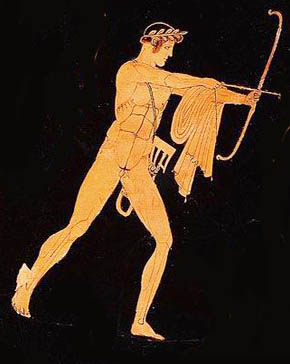Excursions
Homer and Others:
A New Paradigm
E Bruce Brooks and Keith L Yoder
First, there were the bards, singing their hero tales in return for supper and a night's lodging, up and down the isles and towns of Ionia.
Then came the poet we may agree to call Homer, who drew on those tales, and added new material of his own, to make a poem which he himself called the Menis: The Rage of Achilles. It had a single story line: an insult to Achilles, its resolution, and its conclusion in Achilles' slaying of Hector. It omitted many traditional tales (high school students who think they are going to read about the Trojan Horse are invariably disappointed), but it does give a version of the war, and posterity has called it the Iliad. To that poem were later added several scenes and episodes, to further embroider the basic story. The final version was regularly performed at Athens. It became Greece's textbook of itself, sold in bookstores and annotated by schoolmasters.
Somewhere along the line, there appeared another long poem, not about heroes, but about the wanderings of resourceful Odysseus and the fidelity of his wife Penelope. It was a complement to the older Iliad. It never achieved the national status of the Iliad (only war can unify a nation, or a group of states), but it did remain in the Homeric repertoire, and the two poems gradually influenced each other, becoming more compatible as parts of that single repertoire. Specifically, the Odyssey became a little more violent than it had originally been, and this in turn had echoes in the Iliad also.
This literary history is not at all clear in the poems as we have them; it needs to be dug out of hints embedded, but nevertheless there and findable, in the two present texts. The performance aspect, in particular, remains to be adequately investigated. Hence this book. It picks up on the observations of many over the years, and adds to these a few further suggestions, some of them based on a new type of stylistic analysis. The book shows how some early songs were combined with new material to make the ambitious Menis, how the Odyssey arose in the same tradition but from a different impulse, and how the two influenced each other, to become the texts which the city of Athens took over, and which, with a little help from the Athenian schoolmasters, became the Odyssey and the Iliad which we now have.
Front Matter
Cover
Halftitle, with Advisors, 1-2
Title Page and Verso, 3-4
Dedication, 5-6
Preface, 7-8
Contents, 9-10
Prolegomena, 11-18
Early Singers
1. *Demodocus, 21-25
2.
Agamemnon (Iliad 11), 26-35
3. *Paris (Iliad 3-4), 36-37
4. *The Ships (Iliad 2), 38-41
5. Diomedes (Iliad 5), 42-
6. *Odysseus
7. *Melanippos
8. The Wall
9. The Long Books (Iliad 11, 13, 15-17)
10. Aeneas
11. Aegisthus (Odyssey 1)
12.
Dawn (Iliad 1)
13.
Endings
The Iliad
14. *The Quarrel (Iliad 1)
15. *The Menis
16. *Andromache (Iliad 6, 22, 24)
17. *Thersites (Iliad 2)
18.
Phoinix (Iliad 9)
19. *Nestor
20. *Sarpedon
21. *The Shield (Iliad 19)
22.
Dolon (Iliad 10)
23.
Games (Iliad 23)
24.
Priam (Iliad 24)
25.
Athens
26.
In School
The Odyssey
27. The Moral Universe (Odyssey 1)
28. *Polis and Parlor
29. *Telemachus (Odyssey 1-4.15, 2)
30. *Calypso (Odyssey 5-8)
31. *Cyclops (Odyssey 10)
32. *Circe (Odyssey 10)
33.
Anticleia (Odyssey 11)
34. *Eumaios (Odyssey 14)
35. *Eurycleia (Odyssey 19)
36. *Theoclymenos (Odyssey 15, 17, 20)
37.
The Bow (Odyssey 21)
38. *Penelope (Odyssey 23)
39.
Patrimony
40. *Athena (Odyssey 24)
Epilegomena, 231-236
End Matter (237-238)
Chronology, 239-240
Homer's Iliad, 241
The Original Odyssey, 242
Works Cited, 243-252
Passages Discussed, 253-254
Subject Index, 255-256
*Uses the BIRD stylistic difference test which was introduced in the Overview
Contact The Project / Exit to Books Page
